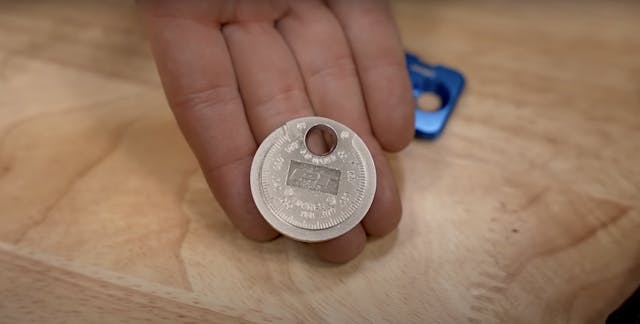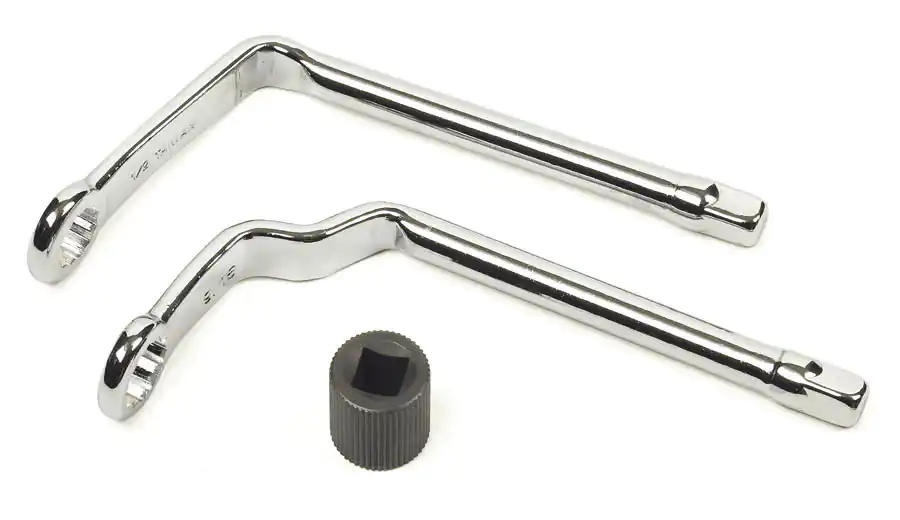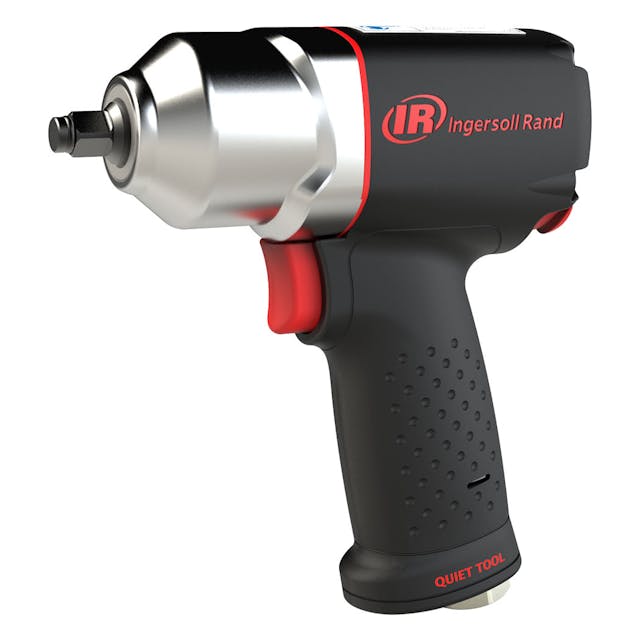9 old tools almost nobody uses anymore

The nuts and bolts that make up our beloved automobiles have not changed that much over the last 150 years. But the tools needed to maintain them? Those have changed a lot. Software has cemented itself as part of a service technician’s day-to-day regimen, relegating a handful of tools to the history books. (Or, perhaps, to niche shops or private garages that keep many aging cars alive and on the road.)
How many of these now-obsolete tools do you have in your garage? More to the point, which are you still regularly using?
Spark-plug gap tool

Though spark-plug gap tools can still be found in the “impulse buy” section of your favorite parts store, these have been all but eliminated from regular use by the growing popularity of iridium and platinum plugs. These rare-earth metals are extremely resistant to degradation but, when it comes time to set the proper gap between the ground strap and electrode, they are very delicate. That’s why the factory sets the gap when the plug is produced.
These modern plugs often work well in older engines, meaning that gapping plugs is left for luddites—those who like doing things the old way just because. Nothing wrong with that; but don’t be surprised if dedicated plug-gapping tools fade from common usage fairly quickly.
Verdict: Keep. Takes up no real space.
Dwell meter

50 years ago, a tuneup of an engine centered on the ignition system. The breaker points are critical to a properly functioning ignition system, and timing how long those points are closed (the “dwell”) determines how much charge is built up in the ignition coil and thus discharged through the spark plug. Poorly timed ignition discharge is wasted energy, but points-based ignition systems disappeared from factory floors decades ago, and drop-in electronic ignition setups have never been more reliable (or polarizing—but we’ll leave that verdict up to you.)
Setting the point gap properly is usually enough to keep an engine running well, and modern multifunction timing lights can include a dwell meter for those who really need it. A dedicated dwell meter is an outdated tool for a modern mechanic, and thus most of the vintage ones are left to estate sales and online auction sites.
Verdict: Toss once it stops working. Modern versions are affordable and multifunctional.
Distributor wrench

When mechanics did a lot of regular timing adjustments and tuning, a purposely bent distributor wrench made their lives much easier. However, much like ignition points, distributors have all but disappeared. Thanks to coil-on-plug ignition systems and computer-controlled timing, the distributor is little more than a messenger: It simply tells the computer where the engine is at in its rotation.
Timing adjustments have become so uncommon that a job-specific tool is likely a waste of space. If you’ve got room in your tool chest, keep yours around; but know that a standard box-end wrench can usually get the job done and is only fractionally less convenient than the specialized version.
Verdict: Keep if you have them. No need to buy if you don’t.
Pre-OBDII diagnostic scan tools

Prior to the required standardization of on-board diagnostic computers by the U.S. in 1996, a single car could host a wild mix of analog and digital diagnostic methods. OBDII, which stands for On-Board Diagnostic II, wasn’t the first time that a small computer was used to pull information from the vehicle via an electronic connection; it merely standardized the language.
Throughout the 1980s and early 1990s each OEM had its own version of a scan tool. Now those tools can be reverse-engineered and functionally spoofed by a modern computer, allowing access to diagnostic info tools that, at the time, were only available to dealers. Since many pre-OBDII cars are now treated as classics or antiques and driven far less frequently, the need for period-correct diagnostic tools is dropping.
Verdict: Keep. These will only get harder to find with time, and working versions will be even rarer.
Distributor machine
A distributor is simple in concept. Trying to balance the performance and economy of the ignition system, with the distributor attached to a running engine, and achieving proper operation starts to get pretty complicated. That’s where a distributor machine comes in.
A distributor is attached to the apparatus and spun at engine speed by an electric motor. This allows you to literally see how the points are opening and closing. You can also evaluate the function of vacuum or mechanical advance systems. These machines are still great but the frequency that this service is needed these days is few and far between, especially when trying to justify keeping a large tool around and properly calibrated.
Verdict: Keep, if you are a specialty shop or tool collector.
Engine analyzer

Even a casual enthusiast can see there is a lot more information that can be gleaned from a running engine than whatever readouts might be on the dash. Enter the engine analyzer, a rolling cabinet of sensors and processors designed to fill in the data gaps between everything that is happening in a car and what its gauges report.
An engine analyzer is essentially a handful of additional instruments packaged into a small box hanging around the bottom of your tool drawers. It can also house a lot of sensors in a giant cabinet, which was likely wheeled into the corner of the shop in 1989 and left to gather dust. Now engine analyzers can be found listed online for as cheap as $200.
The funny thing is that many of the sensors in these engine analyzers are often the same systems that come built into modern dynamometer tuning systems. In a dyno, the sensors allow the operator to see more than max power; they also show how changes to an engine’s tune affect emissions. Maybe engine analyzers didn’t disappear so much as change clothes.
Verdict: Toss. The opportunity cost of the space these take up can be tough for most home garages. Sensors went out of calibration decades ago so the information you might get from one is dubious at best.
Most pneumatic tools (for home shops)

Air tools hold an odd place in the hearts of many gearheads. For many years the high-pitched zizzzz and chugging hammers of air-driven die grinders and impact drills were the marks of a pro. Or, at least, of someone who decided that plumbing high-pressure air lines around the shop was easier than installing outlets and maintaining corded tools. Air tools are fantastic for heavy use, as they are much easier to maintain and can be rebuilt and serviced.
Those tools can really suffer in lack of use, though, since pneumatic tools rely on seals and valves, neither of which deal well with dry storage. Battery tools have caught up to air tools for most DIY folk. No more air lines or compressors taking up space in the shop—and requiring additional maintenance—and, in return, a similarly sized yet more agile tool.
Verdict: Keep, if you already have the compressor. Don’t have one? Invest in battery tools.
Babbitt bearing molds/machining jigs
Every engine rebuild has to have bearings made for it in some fashion. Today’s cars use insert bearings that are mass-produced to surgical tolerances for a multitude of applications. If you wanted—or more accurately needed—new bearings in your Model T circa 1920, you needed to produce your own … in place … inside the engine. Welcome to Babbitt bearings.
The process is a true art form, from the setup of the jigs to the chemistry of pouring molten metal and machining the resulting orbs to actually fit the crankshaft and connecting rods. Now there are newly cast blocks for your T that replace the Babbitt with insert bearings. Since those antique Ford engines just don’t get abused the way they used to, and lead fairly pampered lives, they need rebuilding far less often than they did in-period. Modern oils also do a better job of protecting these delicate bearings. Since they are less and less in demand, the tooling and knowledge to make Babbitt bearings are difficult to find, and precious when you do.
Verdict: Keep. It’s literally critical to keeping a generation of cars alive.
Split-rim tire tools

Among the realm of scary-looking tools that have earned their infamy, split-rim tools hold court. The concept is simple: The rim is sectioned, allowing it to contort into a slight spiral that can be “screwed” into a tire. (This is almost the reverse of a modern tire machine, which stretches the tire around a solid wheel rim.) When tires needed tubes, both tire and rim were relatively fragile, and the roads were rough, split rims were popular—and for good reason. Now the tooling for drop-center wheels is ubiquitous and shops often won’t take on split-rim work. Success is hard to guarantee, even if techs are familiar with split rims—and they rarely are.
Verdict: Keep. No substitute for the right tools with this job.
***
These tools might not make much sense in a dealership technician’s work bay, but that doesn’t mean they should disappear forever. Knowing how to service antiquated technology is as important as ever, whether using old tools or new ones. If you’ve got any of these items, consider it your responsibility to document what the tool does and how to safely use it. Keeping alive the knowledge of where our modern tools came from is powerful.
***
Check out the Hagerty Media homepage so you don’t miss a single story, or better yet, bookmark it. To get our best stories delivered right to your inbox, subscribe to our newsletters.


I still set plug gap with a “feeler gauge” that my dad had; it also can be used to measure many other types of gaps. My 1975 Olds specifies a huge spark plug gap, and no plugs I have used have been pre-set anywhere near that gap. Also, lawn mower plugs need checked, and occasionally changed.
I bought my first car when I was 18 years old from a neighbor for $ 265.00 in 1968. It was a ’60 Chevy Belair with a 283 and 3 on the tree. It was well taken care of, so I was ready to to do the same. I immediately went out and bought all the tune-up stuff a young greenhorn might need ( sparkplug gapper; Dwell Meter; point gap tool and timing light ). That was 1968. Those tools served me well for at least ten years. Fast forward to 2016 and I decided to buy a retirement project ( 1956 Buick ). The first thing to do was a thorough tune-up. A buddy of mine says ”You’re gonna need some specialized tools to do this”. A few minutes later I emerged from the basement with all the tools I had purchased in 1968 !!!!! ( to his surprise !! ) Now they’re still in service maintaining both my ’40 and ’56 Buicks !! ( Anybody need a slightly used toaster ? )
I have a very old “Yankee screwdriver” that I inherited from my father. Made by the Yankee Tool Company. You push on the handle and it turns the interchangeable bit. It has a switch to change the direction. I should sell or donate it since it’s long and doesn’t fit well in my tool chest. I don’t think I’ve ever actually used it, but I know it works.
I sold equipment to shops. Did allot of demos always after hours of course for Engine Analyzers. After OBD 2 came out SUN made the MEA 1500 . Sold for 20K fully loaded. It was still a live oscilloscope. The MCA 3000 came out as well. Sold for 40K. It was a digital oscilloscope. These prices are Canadian. AIR CARE started up and shops spent big bucks and I don’t think many made their money back.
I have to agree with most of the comments. I have most of those tools in my shop and use them regularly on my classic cars, as well as some of my daily drivers.
I also don’t care for the battery powered tools. Yes, they are great for working where you don’t have access to air or an electrical outlet (track-side, on the side of the road, new construction, etc.), BUT the batteries do not last very long (I got less than 2 years on mine) and then a new battery costs more than the price of the tool, IF you can find one. As noted above, they have their place; but I much prefer my air tools in my shop. They are more powerful and always ready to go, plus they last forever!
I still have a dwell meter, which I only use to set the points on GM cars when a drop in trigger has not been installed, which is, um… Just about always. I have not used it in a couple of decades. I have two…
Distributor wrench is still useful, as many of the cars that I work on are still analog, and have distributors that have to be timed.
The distributor machine is something that I would love to own, as they are useful for making changes in the distributor’s advance curve and setting up multiple point distributors. ‘Really important if you have a vintage Ferrari and still have points.
My cars still use OBDII, so a good quality scan tool is useful, but a proper “Star Tester” is even better, as the onboard diagnostic system can be accessed to run various checks, such as computed timing, cylinder balance, and KOER/KOEO sensor and wriggle tests.
I am still torn between adding additional pneumatic tools, or going to batteries. The problem with batteries is that they need to be charged, and often, some tools will go unused for a long period of time, leaving me with uncharged batteries, or batteries with short working times. With the air tools, I switch on the compressor, squirt some oil and I am ready to go. Also, the air tools usually have a higher reverse torque, though I see that this is changing. I am going to need to replace one gun, and add a smaller one, so I am working on this decision as I write this.
I had a chance to get an entire Sun analyzer system when Y2K became a thing and the unit was slated for replacement. But the size of my garage, and the size of the Sun unit were not compatible. That thing was large, with a huge oscilloscope. There was also an alignment rack as well. ‘Wanted that, too, but too big for the garage.
This article made me go out to my “archival” toolbox and spend a few quiet minutes with the dwell meter, timing light, test lamp, and carburetor balancing tool.
the dwell angle is essentially the percentage of time the coil gets to recharge which becomes an isue at higher rpms.
Tel-Tale wiper arm pressure indicator. Found in an old filling station tool box, years ago.
I have not used my BS ( British Standard) / Whitworth wrenches and sockets for a very long time, BTW I think Snap On was the last American supplier for them. Also way back American wrenches came in some 1/32 ” increments no longer used. Brake cylinder hones are another dead item.
S.B.
Yes I have brake hones. My 1941 Plymouth cylinders are no longer, so you have to either hone them, or have them machined and new sleeves installed. I even have a hone my toolmaker dad made for this purpose.
Back in the day every garage had a spark plug cleaner and tester. The guy I worked for would wire it up to his tool box and if anyone other than he touched it he would go push the test button and shock the daylights out of him. Nobody dared to touch his tools!🤭🤭😄
I have saved my old tools like my feeler gauge. I have found plugs not set correct for my 1950 Imperial off just a bit caused it to misfire. My dad always said if you have the old tools use them especially if you a working on an older car makes it easier. That advise hasn’t steered me wrong yet.
What planet are these jokers from? I use the hell out of pneumatic tools, and having TWO Saab Sonett cars AND an Austin-Healey 3000 (1960), you damned betcha I use “sparking plug” tools AND a dwell meter! OH, and no mention of “large sized paper clips”?? I have a specially formed one that shorts two pins of the diagnostic jack on the ’94 Toyota PU, that lets me diagnose codes WITHOUT an OBD reader. (that’s what happens when you’ve grown up on a farm)
Ford tractors came with a 1 1/16” open end wrench with a 9/16” box end on the other end. It fit a lot of nuts
on the tractor. I still have a couple around somewhere. Also my fathers old socket set has an Allen wrench
drive hole. The sockets are all 16 point so they fit the old square nuts that were used years ago. They don’t fit anything made today but I keep them because they were my dads.
I’m 65. When I was about 21, I had a nice old ’61 T-bird with Honey Beige soybean paint. I noticed the brakes fading fast one day, so I limped it into the 3-bay mechanics’ garage not far from my house. The brakes were about gone when I got there. I told the guy clearly what the problem was. He had one of those “Sun” diagnostic cabinets still in use, sitting at the back wall of the bay he was pulling my car into. “Be Careful”, I repeated. He then plowed that scythe-shaped front end right into his cabinet, almost doubling it over. I was horrified, but it was quite a spectacle! He “fixed” the brakes, and two weeks later, they failed completely at the busiest intersection in my city, and I went on a little mille miglia hayride. Thankfully, no cars were wrecked and no one was injured. As I jerked the wheel to avoid a wreck and stomp my emergency brake, my rising knee caught the door handle, and the centrifugal force of my turn made the door fly open, IT hit a car coming toward me and then slammed shut again, and never shut “right” again. It was twisted a bit, somehow. I got a ticket for “defective equipment.” I was a factory worker with a low budget. I went to court and plead my case, saying I shouldn’t be fined because I’d made a good faith effort to address the problem, and brought the receipts. The judge dismissed the ticket, and told me I should go to law school. So I went to law school. A fateful day!